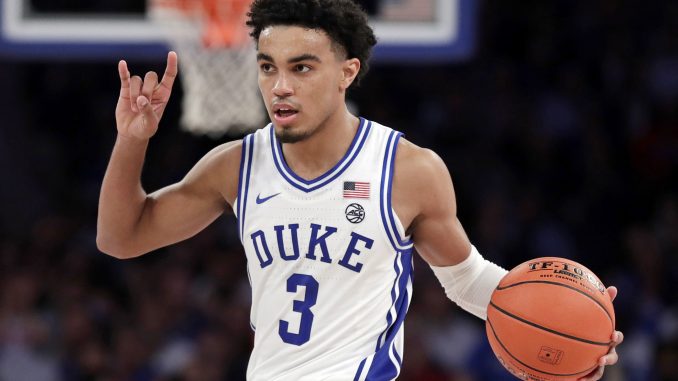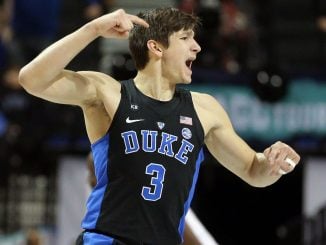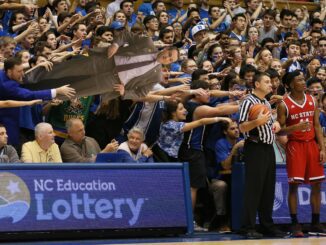
When Boston College traveled to Duke earlier this season, Eagles coach Jim Christian used a brief stop in play to call out the next offensive set for his team.
Standing on the B.C. sideline, Christian extended one arm in the air, then grabbed it by the elbow with his other hand.
“Elbow!” he called to his team, who nodded and began getting into position.
Christian repeated the call, “Elbow!” again grabbing his arm.
Elbow, for the uninitiated, is an offensive set made popular in the NBA. Stan Van Gundy used it extensively with the Orlando Magic. It’s gradually been adopted in college by coaches ranging from Oregon’s Dana Altman to UConn women’s coach Geno Auriemma.
Making his way up court, Duke senior captain Jack White watched Christian make the call to the Eagles, then turned around and made the same arm-grabbing gesture.
“Elbow!” White shouted to his Blue Devil teammates, and the Duke players got into position to defend the set.
The sequence highlighted something that separates basketball from most other sports. Major League Baseball is in the midst of a scandal where players and coaches went to wild lengths, pushing the limits of technology to steal signs from the opposing team. On football sidelines, every reserve player not currently on the field seems to have a role in the complex play-calling schemes that involve photos of seemingly random objects, multiple decoy signalers and giant opaque screens to keep anyone in the press box from spotting the signals.
And yet, in basketball, there doesn’t seem to be the same concern for secrecy.
It’s often said that there are no secrets in the ACC. The teams know each other so well from scouting and long histories of playing each other that they know their opponents’ plays as well as their own.
“I noticed that just from our scouting,” said Duke freshman Cassius Stanley, who is getting his first taste of conference play. “Our scouting picked up tremendously from nonconference to conference. We get so much more information on tendencies and habits. And we know if we’re doing that, then every team’s going to do that. So we just have to know that one move might not make it. Something you do consistently might be taken away.”
Some teams — Clemson and Louisville in the ACC — even write their play calls on a whiteboard and hold it up, for everyone to see.
In the NBA, Michael Jordan would frequently tell the man he was guarding what play they were supposed to be running if the foe happened to miss the call from his coach.
Why the different approach to secrecy? Wouldn’t basketball teams be able to benefit from the element of surprise, the same as a football team or MLB pitcher?
Let it flow
One reason teams are so blasé about hiding their calls from the bench is that the call is just a starting point.
For example, Duke’s Tre Jones will frequently bring the ball up court and hold up one hand, displaying his index and pinky finger, in a gesture similar to NC State’s wolf hand. He’s calling for the Horns offensive set, which features both post players coming up by the free-throw line, away from the basket, to open up the lane.
That’s the equivalent of a football team coming out with a four-receiver spread or a two-back I-formation. There’s still a play that needs to be run. And, unlike football, where that call comes from the sideline, it usually falls on the players out on the floor to decide what to do.
“Here’s the difference,” former Virginia Tech coach and TV analyst Seth Greenberg said. “You can be running horns, but horns is run in relation to how it’s defended. Our game is a read-and-react game. You can say horns, I can give you 15 different things you can do out of horns.”
Greenberg then went into great detail about hard hedge screens, flare screens, pistol action and shuffle cuts, all of which have been practiced extensively and are available for the players on the floor.

“Our game is more spontaneous, read-and-react,” he said. “If I know that guy’s throwing a fastball, then when it leaves his hand, it’s going to be a fastball. This is a little bit different.”
The other big difference is that there are far fewer opportunities for the sideline to get involved.
“It’s just trying to make plays,” said UNC’s Justin Pierce. “It’s not like baseball or football, where there’s stoppages after each play. Basketball is such a fast-paced, free-flowing game.”
Choosing your moments
Despite the cliché, there are still secrets in the ACC.
“There absolutely are,” said NC State assistant coach James Johnson, a former head coach at Virginia Tech. “Even the guys who hold up signs on whiteboards, there are times late in games when they’ll turn them so our guys can’t see what it says.”
Coaches generally pick and choose the time to keep things close to the vest.
“ATO plays,” Johnson said. “Teams have plays that they run after timeouts. That’s something where we can’t hear the call. They call it in the huddle. They go out. There’s nothing audible. They just run the play. Sometimes you get caught off guard with a new set or something.”
Johnson’s former boss at Virginia Tech, Greenberg, agrees.
“What you have to do as a coach is figure out what you’re going to do to steal a basket,” Greenberg said. “(Missed) free-throw plays. Coming out of timeouts. Are you going to change defenses one time when the other guy doesn’t think you will? Because the games are closer. I did a study at Tech: If you can win special situations — under, side, out of timeout, first plays of half, free-throw situations — if you win those, you’re going to win three or four more games a year.”
On your own
The bottom line is that, with a few exceptions at critical moments in the game, the decision-making is in the hands of the players. They’ve been drilled well in practice, but the call comes from what they’re seeing on the floor at any given time. Duke’s Jones explained that an alley-oop he threw to Stanley against Miami wasn’t the play that had been called in the huddle. “We just made eye contact,” he said, “saw it was going to work, and I threw it.”
“At the end of the day, it’s five guys out there for each team, one ball and one basket,” Pierce said. “You have sets, you have a base offense, but mostly you’re just out there making plays.”



